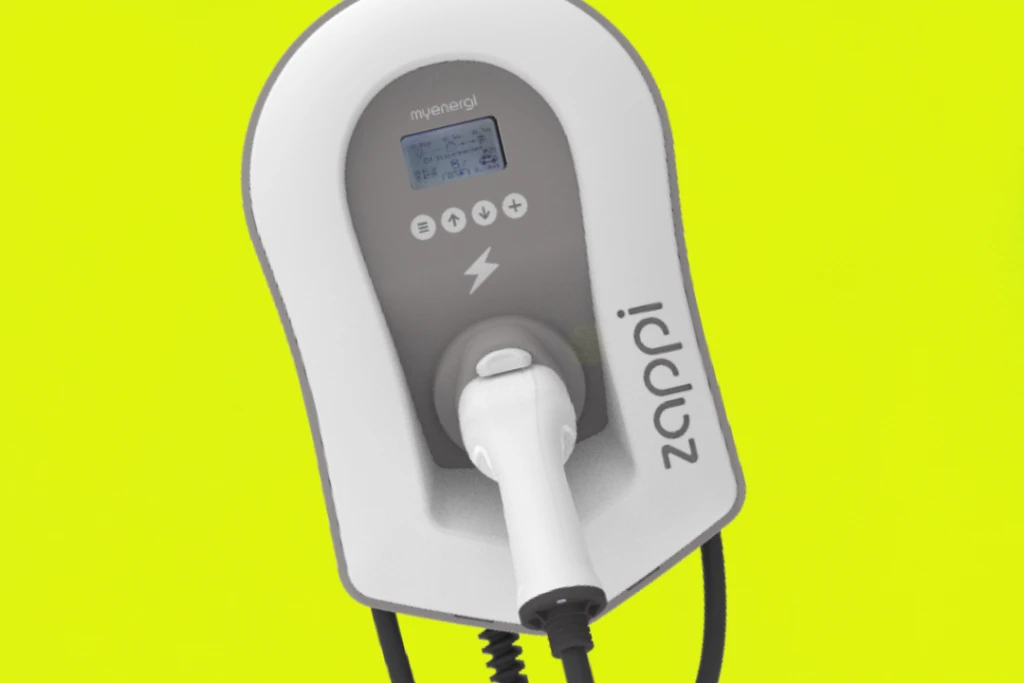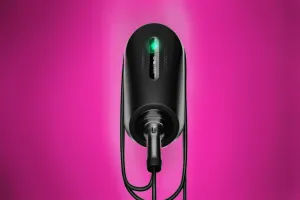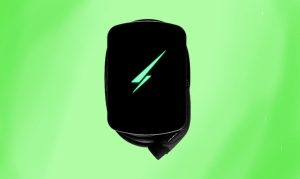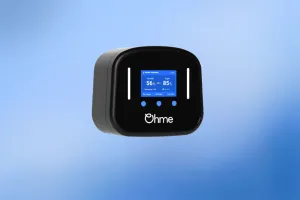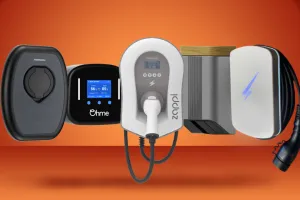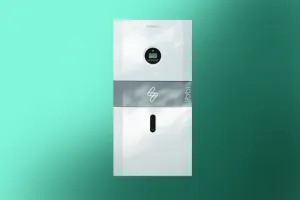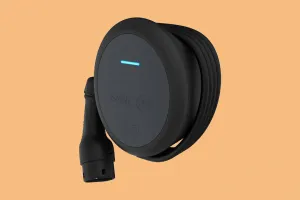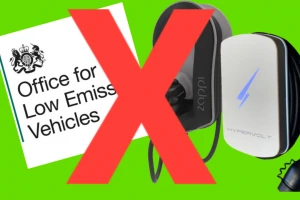One of the most popular and innovative EV chargers currently available is the Zappi v2. Made in Britain by Lincolnshire-based company, Myenergi.
The feature that makes it attractive is the integration with grid-tied microgeneration systems, specifically solar PV or wind turbines which are both commonplace nowadays.
Any potential buyers that don’t have PV/wind turbines should not be put off though as the Zappi works as a regular fast charger like any other.
Myenergi Zappi Overview
The Myenergi Zappi v2.1 updated in 2023 replaces the older v2 and v1 models. The latest model has seen the addition of built-in WiFi and ethernet connectivity and also upgraded security features.
It can be wall or post-mounted and comes in tethered and untethered options.
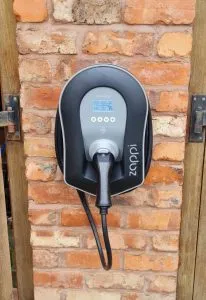
There is a 22kW model for commercial use and for anyone lucky enough to have a 3-phase supply, but for this review we will focus on the 7kW model and its domestic applications.
Myenergi Zappi Design

Features
Solar/wind turbine compatibility
The Myenergi Zappi’s main feature is compatibility with microgeneration systems like solar or wind turbines. For this review, we will assume a PV array is connected (although wind turbines work in the same way).
The Zappi has two eco charging modes, eco and eco+. These modes determine how the car is to be charged in relation to the energy being produced.
It is important to understand that for solar charging to take place there must be surplus/export of 1.4kW back to the grid. This will also need to be continuous for 30 seconds to begin.
Eco-mode
When set to eco mode the Zappi will charge from solar energy, and also grid electricity if required. If the 1.4kW level for solar charging is not achieved the Zappi will use electricity from the grid to help reach the required level. So for example, if the solar has an export/surplus of 1kW then 0.4kW (400W) will be supplied from the grid.
This mode ensures that the car is always charging, and also using the smallest amount of grid electricity possible.
If at any time over 1.4kW is generated then no electricity will be taken from the grid.
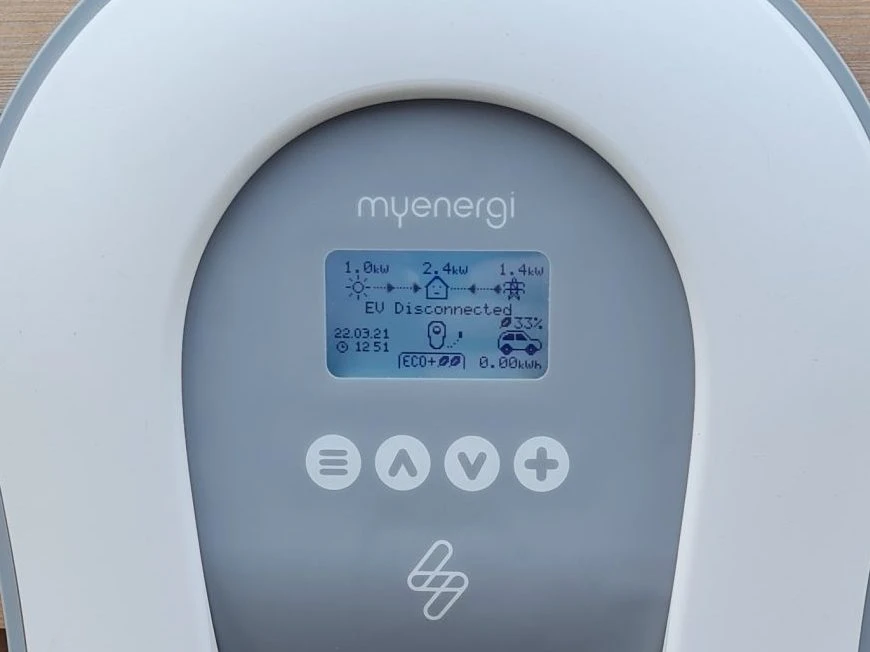
Myenergi Zappi LCD display showing grid import, PV generation and energy consumption in the home.
Eco+ mode
When set to eco+ mode the Zappi works similarly but this time if the Zappi does not receive the 1.4kW surplus from the solar then charging will be paused. Once either the energy consumption from the rest of the house has dropped, or the solar array generates enough surplus energy then charging will continue.
This is the cheapest and ‘greenest’ way to charge but may not always be the most practical. Changes in the weather may cause energy generation to decrease, or during the day various appliances in the home are running, therefore using the surplus power.
Grid limiting/load balancing
Once a premium feature that was pretty much only available with the Zappi is load balancing/grid limiting. This feature is more common now with many chargers but the Zappi still has many options other chargers do not have.
EV chargers place a huge demand on the grid as they are running for long periods. Although household appliances such as electric hobs and showers draw a similar current they are not on for such long periods compared to EV chargers. This is a concern for not only the National Grid but charge point installers who have to ensure the added EV charger will not cause an overload.
The Zappi has a grid-limiting feature that monitors the power usage of your home, this will reduce the charge to the EV if too much demand is drawn in the rest of the home.
For example, if the main fuse of the property is 60A, and the rest of the home is already drawing 40A from other appliances, the Zappi charge rate will reduce from 32A down to 20A. This keeps the load within the 60A limit and prevents overload of the main fuse.
An additional feature of the Zappi is the ability to balance the load between multiple Zappi charge points if additional units are added.
CT Clamps
To monitor loads the Zappi uses a CT clamp. This clamp is placed around the cables from your electric meter to monitor energy usage. Up to 3 clamps can be hard-wired to the Zappi to monitor grid, solar and AC batteries. When it is not practical to hard wire then a Harvi can be used.
Myenergi Harvi wireless monitor
The Harvi is an additional device from Myenergi and is used when a hard-wired CT connection is not possible. It allows up to 3 clamps to be connected and can be used to monitor solar generation.
Unfortunately, it can’t be used for grid monitoring purposes in case there is a loss of connection to the Zappi and overload occurs.
What’s great is that the Harvi does not use batteries or need plugging in, it harvests energy from the electromagnetic field of the cable.
PEN fault detection
For most EV charge point installations it is a requirement they have their own earth connection via an earth rod. However, the Zappi has a PEN fault protection device that omits the need for an earth rod to be installed. The PEN fault protection device constantly monitors the incoming supply neutral and if the connection is lost the device will shut down the charge point preventing a potential electric shock.
Although this feature is probably not top of the list for potential buyers it is another very important one and a great reason to purchase a Zappi.
Wi-fi and ethernet connectivity
Previous models used the Myenergi Hub which connected to your router via ethernet and acted as a gateway to the Myenergi server. An RF signal was previously used to connect to the Zappi. Although the Hub worked well it was hard to boost the signal when required, in comparison to Wi-Fi which is easier with Wi-Fi extenders.
The new Zappi can still connect to the Hub for anyone adding a new Zappi to an existing Myenergi setup.
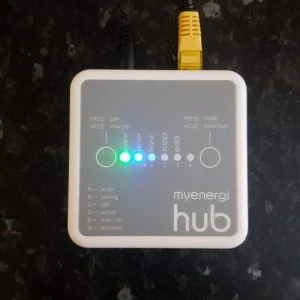
The Myenergi Hub
Myenergi App
The Myenergi app features a simple interface showing how much energy is being drawn from the grid or PV array, and also how much energy is used in the home and to charge your car.
In the center is the ‘green’ icon, which shows the percentage of green energy being used.
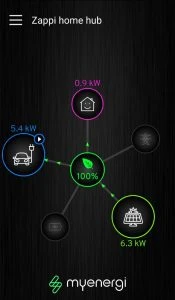
In this screenshot we can see that 6.3kWh of electricity is being generated by the PV array. With 0.9kWh being used by the home, the surplus 5.4kWh is charging the electric vehicle. This is 100% ‘green’ electricity as nothing is being pulled from the grid.
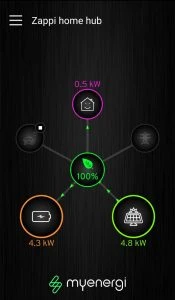
Even when an EV is not charging the app can show energy consumption in the home. The above photo shows surplus generated electricity being diverted to battery storage.
Boost times can also be programmed via the app for overnight charging. This is essential for anyone who has a cheap overnight electricity tariff like the Octopus Go tariff from Octopus Energy. This tariff offers cheaper charging rates for 4 hours overnight, which is great for getting a cheap top-up and can be timed via the smart boost facility.
The app also allows connectivity to the Myenergi Eddi solar diverter. This unit allows excess energy generated from PV systems to heat your hot water. See our review here.
Intelligent Octopus GO Integration
The Myenergi Zappi now has Intelligent Octopus Go integration. This gives a minimum of 6 hours of cheap rate electricity each day. This was previously only available for compatible car manufacturers and Ohme charge points
OCPP Compliant
The Myenergi Zappi is now compliant with the open charge point protocol (OCPP), meaning that third-party software can be used to control charging etc. For Zappi owners this means multiple users can be enabled, each with their own passcode for access. Also, usage statistics can be given for each user which is helpful when tracking business mileage etc.
Zappi Installation
The Zappi fixing kit includes 4 screws, weatherproof washers, and brown wall plugs. The weatherproof washers must be used when installing the Zappi to maintain its IP rating. Failure to use these could invalidate the warranty.
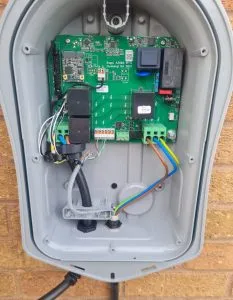
Zappi model options
The Myenergi Zappi is available in both single and three-phase versions. The single-phase unit has a charge rate of 7kWh and three-phase 22kWh.
Most domestic properties in the UK only have a single-phase supply, with commercial properties only really having the benefit of a three-phase supply.
As well as the power options there are also variations in socket or tethered lead models.
The socket model has a Type-2 socket on the front with customers having to use their own charge lead.
Tethered versions have a fixed 6.5m lead. The lead can be wrapped around the unit when not in use to keep it tidy and prevent damage.
All these variations come in either a black or white finish to suit your property.
Zappi Model Numbers
Zappi-2H07UB-G- 7kW, Untethered, Black
Zappi-2H07UW-G – 7kW, Untethered, White
Zappi-2H07TB-G – 7kW, Tetehered, Black
Zappi-2H07TW-G – 7kW, Tethered, White
Zappi-2H22UB-G – 22kW, Untethered, Black
Zappi-2H22UW-G – 22kW, Untethered, White
Zappi-2H22TB-G – 22kW, Tethered, Black
Zappi-2H22TW-G – 22kW, Tethered, White
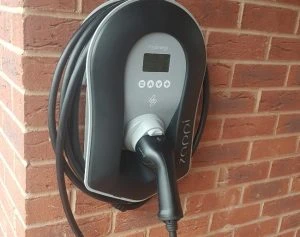
Myenergi Zappi 7kW Tethered model in black
Zappi cost
Warranty
Customers must validate the warranty themselves once installation is complete.
Installation cost
Overview
Overall the Zappi is a fantastic charger. It will not only please those who have solar PV, or those who like their gadgets but anyone who uses it.
The Zappi is slightly more expensive than some of the other EV chargers available, but you are paying for some great features, and also have peace of mind you are using without a doubt the safest charger available.
Although the Zappi unit is more expensive than others the installation costs should cost less – due to the omission of the earth rod. This equals out the overall cost.
Myenergi is a forward-thinking company always trying to improve its products and regularly add new features. They also promote sustainability and this reflects in their products. For example, the Zappi comes in completely plastic-free recyclable packaging, small touches like this add to the Zappi experience.
All in all a fantastic EV charge point!
